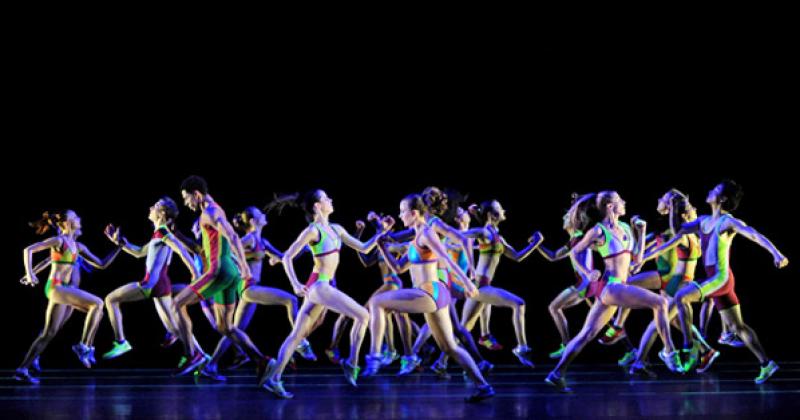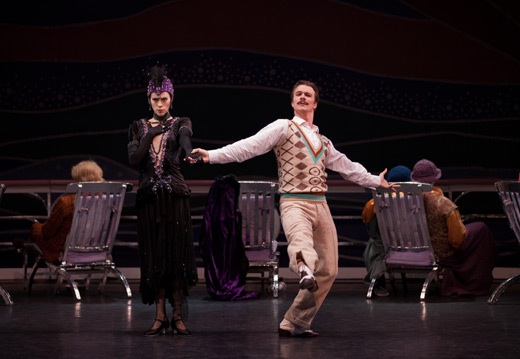Birmingham Royal Ballet, The Grand Tour/ Faster/ The Dream, Sadler's Wells | reviews, news & interviews
Birmingham Royal Ballet, The Grand Tour/ Faster/ The Dream, Sadler's Wells
Birmingham Royal Ballet, The Grand Tour/ Faster/ The Dream, Sadler's Wells
An autumn trio that leaps from Twenties movie stars to military fairies via the Olympics

Birmingham Royal Ballet’s second triple bill at Sadler’s Wells this week is aptly titled "Autumn Celebration", acknowledging the season’s diverse weather through eclectic, light-hearted programming.
Joe Layton’s The Grand Tour is a nostalgic 1971 comedy-ballet about the heyday of the 1920s and the escapist glamour of sea travel. John Conklin’s art deco set and costume designs are supported by a Noël Coward score (adapted and orchestrated by Hershy Kay) that ranges from toe-tapping to shoulder-swooning musical numbers. Coward features as a character on board, and Layton uses other celebrities of the time (as well as some “normal” people) to convey an essence of the era. Fine examples are the screen siren Theda Bara, played provocatively by Samara Downs, and Matthew Lawrence’s Noel Coward, evoking the melancholic side of the jack-of-all-trades.
 Layton was perhaps influenced by Jerome Robbins, the celebrated American choreographer of both Broadway and the New York City Ballet, as there are similarities in their use of comic timing, as well as a direct reference to The Cage when the Bara figure slyly attacks the helpless George Bernard Shaw just as Robbins’s pack-mentality female insects do their own male prey.
Layton was perhaps influenced by Jerome Robbins, the celebrated American choreographer of both Broadway and the New York City Ballet, as there are similarities in their use of comic timing, as well as a direct reference to The Cage when the Bara figure slyly attacks the helpless George Bernard Shaw just as Robbins’s pack-mentality female insects do their own male prey.
David Bintley’s new creation for the Olympic year, Faster, has a sense of perpetual dynamism from the moment Matthew Hindson’s vigorous score begins, and takes the audience on an expedition through sport by discussing both the highs and lows of athletes’ existences. Bintley’s idiom is a fusion of classical ballet and high-end jazz that sees recognisable steps evolve into a hybrid form that’s less stifled and more freewheeling.
The piece’s overall structure is divided into three sections – the first and third being ensemble numbers that ebb and flow between a full and fractured cast, and the middle, a tussling pas de deux for two wrestling athletes that questions injury and its many issues. The female dancer (Elisha Willis) writhes in pain before journeying to a point of resolution – it communicates a rare insight into what actually happens off the stage.
A synchronised-swimming section communicates a sense of glamour like that of Esther Williams, and the final Marathon section sees Bintley use simple running/hopping phrases to accentuate the intensity of the score’s rhythmical underpinning. Becs Andrews’s set design is deliciously minimal and her training-inspired costumes give Stella McCartney’s Team GB offerings a serious run for their money.
The two human couples lost in a game of love and hate beyond their control kept the usual overacting at bay
Ashton’s The Dream (1964) closes the programme, using Shakespeare’s comedy of errors-style narrative to highlight through dance the power fairy-folk have over mere mortals. The choreography portrays the fairies as a militantly romantic army, executing regimental patternings with a lush, mischievous manner; and the BRB corps de ballet performed this with an obvious ease.
The two human couples lost in a game of love and hate beyond their control kept the usual overacting at bay, and Jonathan Caguioa as Bottom roused plenty of giggles with his hind-leg pointe-work. Mathias Dingman seemed on first sight too tall for a Puck, but soon proved he could wrap his long body around the finicky choreography just as adeptly as any slighter dancer could.
César Morales as Oberon showed a keen technical prowess by flitting between controlled passages and frenzied turn sequences with playful abandon, and Momoko Hirata played Titania with a feminine arrogance – translated through an expressive upper body, knife-sharp footwork, and a vivacity that projected far beyond the proscenium.
The Royal Ballet Sinfonia, expertly guided by Philip Ellis, did the verdant Mendelssohn score more than proud – as they did throughout the entire evening.
Watch American Ballet Theatre in the lovers' misunderstanding in The Dream
rating
Share this article
The future of Arts Journalism
You can stop theartsdesk.com closing!
We urgently need financing to survive. Our fundraising drive has thus far raised £49,000 but we need to reach £100,000 or we will be forced to close. Please contribute here: https://gofund.me/c3f6033d
And if you can forward this information to anyone who might assist, we’d be grateful.

Subscribe to theartsdesk.com
Thank you for continuing to read our work on theartsdesk.com. For unlimited access to every article in its entirety, including our archive of more than 15,000 pieces, we're asking for £5 per month or £40 per year. We feel it's a very good deal, and hope you do too.
To take a subscription now simply click here.
And if you're looking for that extra gift for a friend or family member, why not treat them to a theartsdesk.com gift subscription?
more Dance
 'We are bowled over!' Thank you for your messages of love and support
Much-appreciated words of commendation from readers and the cultural community
'We are bowled over!' Thank you for your messages of love and support
Much-appreciated words of commendation from readers and the cultural community
 R:Evolution, English National Ballet, Sadler's Wells review - a vibrant survey of ballet in four acts
ENB set the bar high with this mixed bill, but they meet its challenges thrillingly
R:Evolution, English National Ballet, Sadler's Wells review - a vibrant survey of ballet in four acts
ENB set the bar high with this mixed bill, but they meet its challenges thrillingly
 Like Water for Chocolate, Royal Ballet review - splendid dancing and sets, but there's too much plot
Christopher Wheeldon's version looks great but is too muddling to connect with fully
Like Water for Chocolate, Royal Ballet review - splendid dancing and sets, but there's too much plot
Christopher Wheeldon's version looks great but is too muddling to connect with fully
 iD-Reloaded, Cirque Éloize, Marlowe Theatre, Canterbury review - attitude, energy and invention
A riotous blend of urban dance music, hip hop and contemporary circus
iD-Reloaded, Cirque Éloize, Marlowe Theatre, Canterbury review - attitude, energy and invention
A riotous blend of urban dance music, hip hop and contemporary circus
 How to be a Dancer in 72,000 Easy Lessons, Teaċ Daṁsa review - a riveting account of a life in dance
Michael Keegan-Dolan's unique hybrid of physical theatre and comic monologue
How to be a Dancer in 72,000 Easy Lessons, Teaċ Daṁsa review - a riveting account of a life in dance
Michael Keegan-Dolan's unique hybrid of physical theatre and comic monologue
 A Single Man, Linbury Theatre review - an anatomy of melancholy, with breaks in the clouds
Ed Watson and Jonathan Goddard are extraordinary in Jonathan Watkins' dance theatre adaptation of Isherwood's novel
A Single Man, Linbury Theatre review - an anatomy of melancholy, with breaks in the clouds
Ed Watson and Jonathan Goddard are extraordinary in Jonathan Watkins' dance theatre adaptation of Isherwood's novel
 Peaky Blinders: The Redemption of Thomas Shelby, Rambert, Sadler's Wells review - exciting dancing, if you can see it
Six TV series reduced to 100 minutes' dance time doesn't quite compute
Peaky Blinders: The Redemption of Thomas Shelby, Rambert, Sadler's Wells review - exciting dancing, if you can see it
Six TV series reduced to 100 minutes' dance time doesn't quite compute
 Giselle, National Ballet of Japan review - return of a classic, refreshed and impeccably danced
First visit by Miyako Yoshida's company leaves you wanting more
Giselle, National Ballet of Japan review - return of a classic, refreshed and impeccably danced
First visit by Miyako Yoshida's company leaves you wanting more
 Quadrophenia, Sadler's Wells review - missed opportunity to give new stage life to a Who classic
The brilliant cast need a tighter score and a stronger narrative
Quadrophenia, Sadler's Wells review - missed opportunity to give new stage life to a Who classic
The brilliant cast need a tighter score and a stronger narrative
 The Midnight Bell, Sadler's Wells review - a first reprise for one of Matthew Bourne's most compelling shows to date
The after-hours lives of the sad and lonely are drawn with compassion, originality and skill
The Midnight Bell, Sadler's Wells review - a first reprise for one of Matthew Bourne's most compelling shows to date
The after-hours lives of the sad and lonely are drawn with compassion, originality and skill
 Ballet to Broadway: Wheeldon Works, Royal Ballet review - the impressive range and reach of Christopher Wheeldon's craft
The title says it: as dancemaker, as creative magnet, the man clearly works his socks off
Ballet to Broadway: Wheeldon Works, Royal Ballet review - the impressive range and reach of Christopher Wheeldon's craft
The title says it: as dancemaker, as creative magnet, the man clearly works his socks off
 The Forsythe Programme, English National Ballet review - brains, beauty and bravura
Once again the veteran choreographer and maverick William Forsythe raises ENB's game
The Forsythe Programme, English National Ballet review - brains, beauty and bravura
Once again the veteran choreographer and maverick William Forsythe raises ENB's game

Add comment